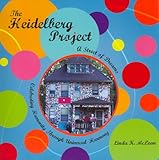The Solution to Reading Comprehension
Lessons & Units :: The Heidelberg Project: A Street of Dreams 5th Grade Unit
Paired Text Questions: "Not-So-Looney Toons" & The Heidelberg Project: A Street of Dreams
Lesson Plan
The Heidelberg Project: A Street of Dreams

- Learning Goal
- Integrate information from the non-fiction passage “Not-So-Looney Toons” and the book The Heidelberg Project: A Street of Dreams to compare art and editorial cartoons, especially in respect to their functions.
- Necessary Materials
- Provided:
- Questions
- Non-fiction reading passage “Not-So-Looney Toons”
Not Provided:
The Heidelberg Project: A Street of Dreams
- Questions 1 and 2 refer to the non-fiction passage “Not-So-Looney Toons.” Questions 3 and 4 refer to the book The Heidelberg Project: A Street of Dreams. Questions 5, 6, and 7 refer to both the passage and the book.
- Student versions of the questions are in the 'Text & Materials' tab.
Part 1: "Not-So-Looney Toons"
Read the passage “Not-So-Looney Toons” out loud to your students. Alternatively, students can read the passage independently or as a group.
Question 1: According to the passage, what is an editorial cartoon?
Sample student answer (responses may vary but should resemble the following): An editorial cartoon is a cartoon that makes a person laugh and think, drawn to express the artist’s opinion about an issue in the news.
Question 2: Explain why an editorial cartoon might make someone think. Support your answer with evidence from the passage.
Sample student answer: Responses may vary, as long as they are supported by the passage. For example, students may respond that an editorial cartoon might make someone think because of its use of symbolism. A person may need to think about what the symbols in the cartoon mean and put them together in order to figure out the artist’s opinion. Looking at Mike Thompson’s Iraq war cartoon, for instance, a person might need to think about what a bald eagle tossing the “NEW IRAQI GOV’T” egg off a cliff represents.
Part 2: The Heidelberg Project: A Street of Dreams
Question 3: Tyree Guyton created an art installment for the United We Walk program that featured an iron, an ironing board, an American flag, and shoes. Describe what this art installation looked like.
Sample student answer (responses may vary but should resemble the following): The art installation showed an American flag being ironed. The ironing board was surrounded by shoes.
Question 4: What might this art installation make people think about? Why?
Sample student answer: Responses may vary. Some students may give literal-minded responses, such as “ironing” or “walking.” Encourage them to think more deeply about the relationship of objects in this installation to each other. They may see the work as a representation of American problem-solving—the shoes representing the people of the United States gathered around an ironing board, where they are trying to smooth the country out. Or maybe the shoes show that lots of people are just standing around waiting for someone else to come along and iron out their country’s problems. Many interpretations are possible here.
Part 3: "Not-So-Looney Toons” and The Heidelberg Project: A Street of Dreams
Question 5: What are some differences between editorial cartoons and Tyree Guyton’s art installations?
Sample student answer: Responses may vary but should reflect the texts. For example:
- Editorial cartoons are meant to make people laugh, but not all of Tyree Guyton’s art installations are meant to make people laugh.
- Editorial cartoons appear in newspapers, but much of Tyree Guyton’s work is found on a street in Detroit.
- Editorial cartoons are two-dimensional, but Tyree Guyton’s work is three-dimensional.
Question 6: What are some similarities between editorial cartoons and Tyree Guyton’s art installations?
Sample student answer: Responses may vary but should reflect the texts. For example:
- Both editorial cartoons and Tyree Guyton’s art installations use symbolism to communicate ideas.
- Both editorial cartoons and Tyree Guyton’s art installations address ideas about war, politics, and society.
Question 7: Based on your responses to Questions 5 and 6, are editorial cartoons art? Explain why or why not.
Sample student answer: Responses may vary, as long as they are well-supported. Students responding that editorial cartoons are art may point out that both editorial cartoons and Tyree Guyton’s art installations have a similar function: getting people to think. They both get people to think by using symbolism to communicate ideas about important issues involving government and society. On the other hand, students responding that editorial cartoons are not art could point out that the focus on laughter and the “lighthearted” quality of an editorial cartoon may differentiate it from full-fledged art that takes itself seriously.
Texts & Materials
Standards Alignment
(To see all of the ReadWorks lessons aligned to your standards, click here.)



My classroom consists of students of varying abilities and reading fluencies. Read Works is the best source I have found to assist with the unique learning requirements of my students.